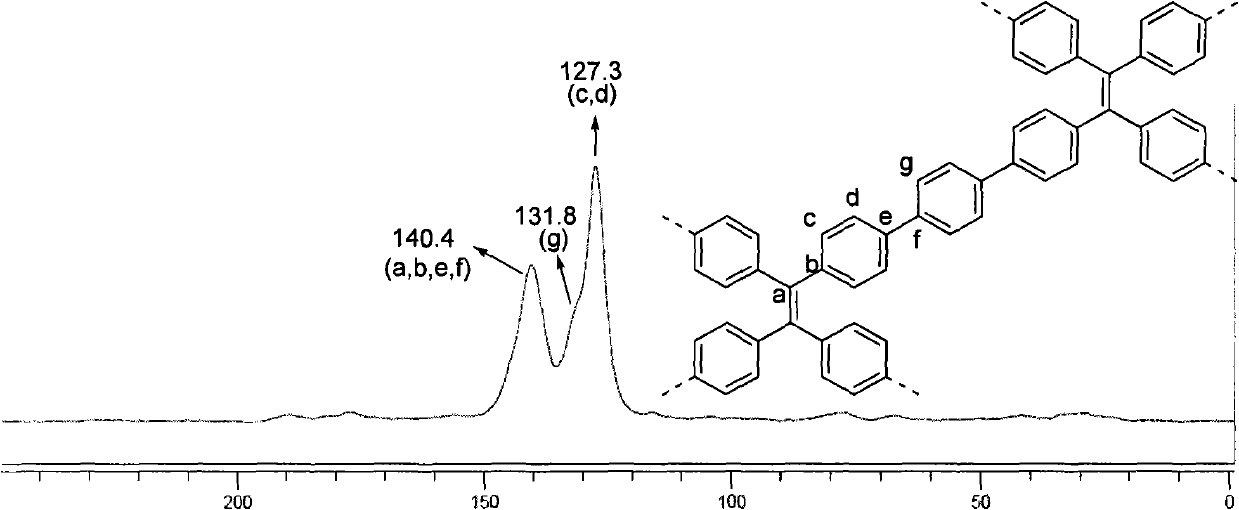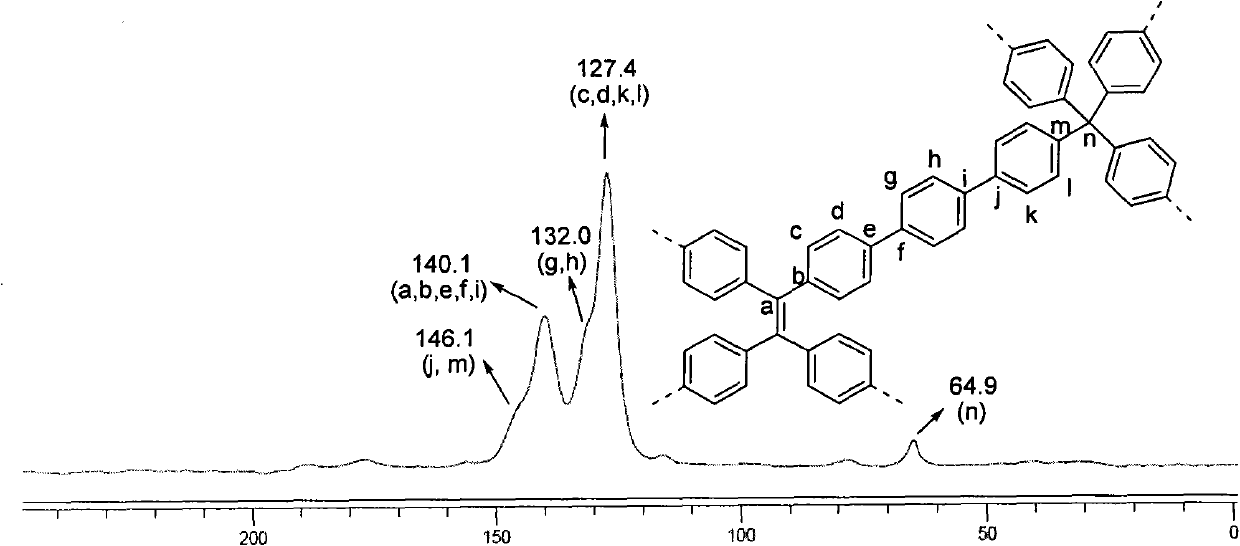Fluorescence nanometer organic porous material as well as preparation method and application thereof
A technology of porous materials and fluorescent nanometers, applied in luminescent materials, organic chemistry, fluorescence/phosphorescence, etc., can solve the problems that organic porous materials cannot be used for fluorescence detection, etc., and achieve the effect of broad application prospects
- Summary
- Abstract
- Description
- Claims
- Application Information
AI Technical Summary
Problems solved by technology
Method used
Image
Examples
preparation example Construction
[0018] A method for preparing a fluorescent nano-organic porous material, the method comprises: under the condition of Suzuki-Miyaura reaction, in an inert atmosphere, in the presence of a palladium-containing catalyst, an alkali metal carbonate aqueous solution and an organic solvent, organic molecules are A building block is in contact with a linker molecule; the organic molecular building block contains tetrakis(4-bromophenyl)ethylene, and the linker molecule is one or more of terephthalic acid, isophthalic diboronic acid, and phthalic diboronic acid .
[0019] In the preparation method of the present invention, the molar ratio of the organic molecular building block to the linking molecule is 1:1.5-2.5, and considering optimizing the properties of the material obtained by the polymerization reaction, the organic molecular building block and the The molar ratio of the linking molecules is preferably 1:2.
[0020] In the preparation method of the present invention, the cont...
Embodiment 1
[0032] Preparation of tetrakis(4-bromophenyl)ethylene
[0033] Into a 150mL round-bottom flask, add 1g 4,4'-dibromobenzophenone (2.94mmol) (Sahn Chemical Technology Co., Ltd.), 2g zinc powder (30mmol), 5.8g TiCl 3 / AlCl 3 (TiCl 3 6.7 mmol) (Alfa Aesar Chemical Co., Ltd.) and 100 mL of tetrahydrofuran. The system was stirred and refluxed for 12 h under nitrogen protection. After the reaction was completed, the system was cooled to 25 °C, filtered, 100 mL of ethyl acetate was added to the filtrate, 100 mL of water was added, and the water layer and the organic layer were separated, and the organic layer was collected, and 15 g of anhydrous sodium sulfate was added. After drying, the sodium sulfate solid was discarded, and the solvent in the remaining liquid was removed by rotary evaporation to give 0.9 g of tetrakis(4-bromophenyl)ethylene (1.40 mmol) in 95% yield.
[0034]
[0035] The product was characterized by H NMR spectroscopy and was consistent with the structural c...
Embodiment 2
[0037] Preparation of Fluorescent Nano-organic Porous Materials
[0038] Into a 150 mL round bottom flask were added 162 mg of tetrakis(4-bromophenyl)ethylene (0.25 mmol) prepared in Example 1, 83 mg of terephenyl diboronic acid (0.5 mmol) (Alfa Aesar Chemical Co., Ltd.) and 64 mL of N,N - Dimethylformamide (Sinopharm Chemical Reagent Co., Ltd.). Stir at 25°C until all solids are dissolved, then add 2M potassium carbonate aqueous solution (8.0 mL), then the system is subjected to two vacuum degassing treatments, and 20 mg of catalyst Pd (PPh) is added. 3 ) 4 (Bailingwei Technology Co., Ltd.), degassed in vacuum again, and then the system was stirred at 150° C. for 24 h under nitrogen protection.
[0039]
[0040]After the reaction was completed and the temperature of the reaction system dropped to 25°C, the mixture was poured into water, the solid was filtered off with suction, and the filter cake was washed with water, dichloromethane and methanol in turn. The solid was...
PUM
| Property | Measurement | Unit |
|---|---|---|
| pore size | aaaaa | aaaaa |
| specific surface area | aaaaa | aaaaa |
| specific surface area | aaaaa | aaaaa |
Abstract
Description
Claims
Application Information
 Login to View More
Login to View More - R&D
- Intellectual Property
- Life Sciences
- Materials
- Tech Scout
- Unparalleled Data Quality
- Higher Quality Content
- 60% Fewer Hallucinations
Browse by: Latest US Patents, China's latest patents, Technical Efficacy Thesaurus, Application Domain, Technology Topic, Popular Technical Reports.
© 2025 PatSnap. All rights reserved.Legal|Privacy policy|Modern Slavery Act Transparency Statement|Sitemap|About US| Contact US: help@patsnap.com



